Writings From the Ancient World (16 vols.)
Digital Logos Edition
Overview
The Society of Biblical Literature (SBL) publishes books intended to convey the finest biblical scholarship to students in college, university, and seminary courses, leaders in church and synagogue settings, and members of the general public interested in biblical study. The SBL offers these 16 volumes of Writings from the Ancient World to provide teachers, literary critics, historians, general readers, and students direct access to key ancient Near Eastern writings that date from the beginning of the Sumerian civilization to the age of Alexander the Great. The volumes typically offer historical and literary background to the writings, the original text and English translation, explanatory or textual notes, and a bibliography.
These ancient writings—letters, laws, government documents, poems, prayers and rituals—provide a glimpse into the social, economic and religious context of other civilizations before and during early biblical times.

- Title: Writings From the Ancient World (16 vols.)
- Publisher: Society of Biblical Literature
- Volumes: 16
- Pages: 4,346
This title is included in the following collections
You can save when you purchase this product as part of a collection.
2025 SDA Gold
$849.99$679.992025 Researcher Diamond Librar...
$2,999.99$2,249.992025 Anglican Diamond
$2,999.99$2,249.992025 Charismatic Diamond
$2,999.99$2,249.99
- $2,999.99$2,249.99
- $2,999.99$2,249.99
- $2,999.99$2,249.99
- $3,149.99$2,362.49
- $4,749.99$3,562.49
- $4,749.99$3,562.49
- $4,749.99$3,562.49
- $4,749.99$3,562.49
- $4,749.99$3,562.49
- $4,749.99$3,562.49
- $4,899.99$3,674.99
- $4,749.99
- $4,749.99
- $11,399.99
- $11,399.99
- $23,999.99$17,999.99
- $24,999.99
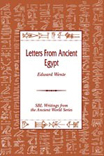
Letters from Ancient Egypt
- Author: Edward F. Wente
- Publisher: Society of Biblical Literature
- Publication Date: 1990
- Pages: 250
Dr. Wente provides translations of most of the letters that have survived reasonably intact from the Old Kingdom through the Twenty-First Dynasty of ancient Egypt. An introduction provides information relating to ancient Egyptian epistolography and discussion regarding the transmission of letters. The organization of the book is basically chronological, with separate sections devoted to royal letters and letters sent by and to the vizier (civil officer). Also included are several model letters that were used in the education of the Egyptian scribe.
Edward Wente is Emeritus Professor of Egyptology at the Oriental Institute of the University of Chicago. He received his Ph.D. at the University of Chicago and taught there until 1996. He has spent many decades studying and teaching Egyptology and in his retirement continues to review translations and evaluate manuscripts submitted for publication to the Journal of Near Eastern Studies, to which he also contributes an occasional book review. He has written many articles for journals, including Encyclopedia Britannica Online. He is the author of Late Ramesside Letters.
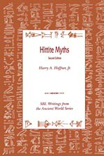
Hittite Myths, 2nd ed.
- Author: Harry A. Hoffner, Jr.
- Publisher: Society of Biblical Literature
- Publication Date: 1998
- Pages: 136
This work contains the first English translations of a collection of Hittite myths. The translations are based on the original tablets on which the myths were written and take into account recent textual discoveries and published studies on the texts. Revised and corrected, this second edition includes an additional newly published Hurrian myth. In addition to translations, the volume includes a series of brief introductions to the myths, a glossary of names and technical terms, and indexes of proper names and topics/subjects. Accessible to nonspecialists, the translations also preserve column and line count for the convenience of scholars.
Harry Hoffner is Professor of Hittitology and Co-Director of the Chicago Hittite Dictionary, University of Chicago. He is the author of The Laws of the Hittites and co-author of A Grammar of the Hittite Language.

Letters from Early Mesopotamia
- Author: Piotr Michalowski
- Publisher: Society of Biblical Literature
- Publication Date: 1993
- Pages: 152
This volume provides a selection of letters from ancient Western Asia up to the time of the First Dynasty of Isin. These letters were written on clay tablets with the cuneiform script; they are the earliest epistolary writings known to us from any part of the globe. The texts are translated from three languages—Sumerian, Eblaite, and Old Akkadian—all of which are imperfectly understood at present. To give the nonspecialist reader some sense of the original documents, the translations are accompanied by transliterations of the cuneiform texts.
Piotr Michalowski is the George G. Cameron Professor of Ancient Near Eastern Languages and Civilizations at the University of Michigan, Ann Arbor. He received an M.A. from the Department of Mediterranean Archaeology and the Department of Near Eastern Philology from the University of Warsaw, Poland. From Yale University, he acquired an M.Phil. and a Ph.D. He has been on the advisory board and editorial board of several Societies and Committees in association with Oriental research and Mesopotamian civilizations. The author of many articles and book reviews, he has also written Lamentation over the Destruction of Sumer and Ur.
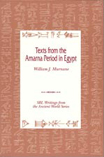
Texts from the Amarna Period in Egypt
- Author: William J. Murnane
- Publisher: Society of Biblical Literature
- Publication Date: 1995
- Pages: 310
In the middle of the fourteenth century B.C.E., Egypt’s polytheistic religion was suddenly attacked by its most traditional upholder, the pharaoh. The short-lived revolution that followed continues to be as disturbing and enigmatic as the “heretic king,” Akhenaten, who set it in motion. Was Akhenaten the first monotheist, as he is widely reputed to be, or was he an opportunist, possibly even an atheist, who cloaked a political revolution in religious terms? Modern readers will now find it easier to address such questions by using this wide-ranging collection of documents, many of them never before translated into English, in which the full sweep of one of ancient history’s most fascinating periods lives anew.
William Murnane received his B.A. from St. Anselm’s College and a Ph.D. from the University of Chicago. He was the author or editor of 12 books, including The Temple of Khonsu, and wrote hundreds of articles on ancient history and culture. He was a visiting professor of Egyptology at the University of California at Berkeley and then joined the Department of History at the University of Memphis, which is where he taught courses on Egyptology and world civilization
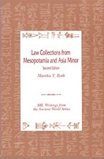
Law Collections from Mesopotamia and Asia Minor, 2nd ed.
- Author: Martha T. Roth
- Publisher: Society of Biblical Literature
- Publication Date: 1997
- Pages: 283
The law collections presented in this volume are compilations, varying in legal and literary sophistication, recorded by scribes in the schools and the royal centers of ancient Mesopotamia and Asia Minor from the end of the third millennium through the middle of the first millennium B.C.E. Sumerian, Babylonian, Assyrian, and Hittite texts, with accompanying English translations, are included. Some of the collections, such as the famous Laws of Hammurabi, achieved a wide audience; others, such as the Laws about Rented Oxen, were scribal exercises limited to a local school center. All, however, reflected contemporary legal practice in the scribes’ recordings of contracts, administrative documents, and court cases and also provide historians with evidence of abstractions of legal rules from specific cases. In addition to the texts and translations, the volume includes a list of sources, bibliography, glossary, and numerous indexes.
The standard reference tool on its subject. Biblical scholars will often refer to it.
—International Review of Biblical Studies
Highly recommended to every student of the Bible and the ancient Near East.
—Journal of Semitic Studies
Martha Roth is Dean of Humanities and the Chauncey S. Boucher Distinguished Service Professor of Assyriology at the University of Chicago. She received her Ph.D. from the University of Pennsylvania in 1979 and has been teaching at Chicago since 1980. The Editor-in-charge of the Chicago Assyrian Dictionary, some of her special interests include Mesopotamian family and social history. Among her dozens of articles, she has also written several books, including Law Collections from Mesopotamia and Asia Minor.
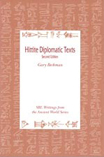
Hittite Diplomatic Texts, 2nd ed.
- Author: Gary M. Beckman
- Publisher: Society of Biblical Literature
- Publication Date: 1996
- Pages: 224
Dr. Beckman presents full translations of more than 50 documents from the files of the "foreign office" of the Hittite Empire: 21 treaties, 18 diplomatic letters, and 18 royal edicts and miscellaneous records concerning the relations of the Hittites with their Anatolian and Syrian vassals, as well as with other great powers such as Egypt, Assyria, and Babylonia. Originally composed in Hittite or in Akkadian, many of these texts have never before appeared in English. A short introduction places each document in its historical and cultural context, and a general essay acquaints the reader with the diplomatic practice of the Late Bronze Age. This collection of documents is a major source book for historians of the Ancient Near East and for students of cuneiform and Biblical law. It will also prove useful for those investigating the relationship between Biblical covenant theology and its possible antecedents in older Near Eastern treaty patterns. The index categorizes its subject matter into persons, deities, cities, countries, districts, people, mountains, rivers and topics for easy access.
We are privileged to have these translations made by one of the leading Hittitologists on the North American continent.…invaluable to scholars of the ancient Near East and of the Bible.
—Biblical Archaeology Review
This is truly an outstanding work. It serves biblical scholarship in general and ancient Near Eastern studies in particular with its superb translations from a civilization which was an important part of the literary and cultural milieu of the Bible. It is a work of reference that deserves to be read widely.
—Catholic Biblical Quarterly
Gary Beckman is the Chair, Department of Near Eastern Studies and Professor of Hittite and Mesopotamian Studies at the University of Michigan, Ann Arbor. He received his B.A. from Pomona College, studying Greek and Hebrew. From Yale University, he acquired an M.A., M.Phil. and a Ph.D. He is the author of Hittite Birth Rituals as well as other books and articles.
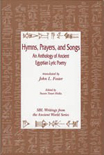
Hymns, Prayers and Songs: An Anthology of Ancient Egyptian Lyric Poetry
- Author: John L. Foster
- Publisher: Society of Biblical Literature
- Publication Date: 1995
- Pages: 171
Foster gives us the first comprehensive anthology in English of ancient Egyptian lyric poetry. Translated from the original Egyptian, the collection emphasizes the value of the ancient poems as literature. The translations retain an accurate sense of the original language, and the poems are set in the proper, “thought couplet” style characteristic of Egyptian verse. Hymns, prayers, and songs pertaining to religion, the pharaohs, death, and love, among other topics, are included. This unique anthology will be of interest to students and scholars alike, in areas as diverse as Egyptian literature and religion, Near Eastern history, and world literature in translation.
John Foster has written or compiled several books of poetry for children. A noted Egyptologist he has translated many writings and poems from hieroglyphics. He is the author of Ancient Egyptian Literature.
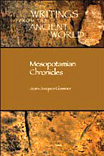
Mesopotamian Chronicles
- Author: Jean-Jacques Glassner
- Publisher: Society of Biblical Literature
- Publication Date: 2004
- Pages: 386
All the chronicle literature of ancient Mesopotamia, from the early second millennium to Seleucid times, is collected in this English translation of Glassner’s Chroniques Mésopotamiennes (Paris: Les Belles Lettres, 1993). In addition to revising and supplementing the French edition, this volume provides transcriptions of the cuneiform and English translations of every example of Sumerian, Assyrian, and Babylonian chronographic literature, as well as seminal essays on the genre and on Mesopotamian historiography in general.
Jean-Jacques Glassner is research director at the French National Center for Scientific Research. He is the co-author of The Invention of Cuneiform.
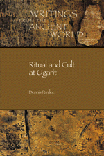
Ritual and Cult at Ugarit
- Author: Dennis Pardee
- Publisher: Society of Biblical Literature
- Publication Date: 2002
- Pages: 316
The Ugaritic ritual texts provide the only extensive documentary data for Late Bronze cultic practice in the greater Syro-Palestinian region. These texts, in a West-Semitic language that belongs to the same family as Hebrew and Aramaic, reflect the actual practice of a sacrificial cult in the city of Ugarit in the late twelfth–early eleventh centuries BCE. Based on new collations of the tablets, these texts and translations provide ready access to this direct witness to the form taken by one of the predecessors of the biblical sacrificial cult. In addition to the narrowly ritual texts, which were composed in prose and in a very laconic form of expression, a number of poetic texts are presented that reveal the ideological link that existed between cultic practice and the concept of royalty. While the prose ritual texts document a regular system of offerings to the great deities of the pantheon, related directly to the lunar cycle and less directly to the solar year, some of the poetic texts reveal the desire on the part of the kings of Ugarit to maintain ties with their departed ancestors.
The kings saw their effective power as consisting of a continuum from the royal ancestors through to the reigning king and the passage of this power as being effected by ritual practice. More mundane concerns were also addressed ritually, such as protecting horses or other equids from snakebite, finding a cure for a sick child, or defending people from attack by sorcerers. The practice of divination at Ugarit is documented by other texts, both in the form of “manuals,” collections of collections of omens from past practice, and in the form of accounts of real-world consultations of a divinatory priest by someone seeking guidance.
Dennis Pardee is Professor of Northwest Semitics in The Oriental Institute at the University of Chicago, which is where he received his Ph.D. in 1974. His other interests lie in Ugaritic/Hebrew poetry, epistolography, and ritual. He is the author of Handbook of Ancient Hebrew Letters.
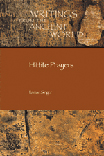
Hittite Prayers
- Author: Itamar Singer
- Publisher: Society of Biblical Literature
- Publication Date: 2002
- Pages: 141
Prayers are among the most personal and imaginative among Hittite texts. Rich in metaphors and similes, they provide the best insight into Hittite contemplative thinking and philosophy of life. In the face of grave illness, the death of a loved one, or an impending military catastrophe, those in crisis disregard the conventional rules of prudent phrasing and cry out from the bottom of their hearts for deliverance and for a better comprehension of their world.
The two dozen royal prayers translated in this volume are grouped in chronological and thematic order: from the earliest invocations and the first personal prayers of the early Hittite Empire (Kantuzili), through the elaborate prayers of Mursili II and Muwatalli II, to the markedly “political” prayers of Hattusili III and his queen Puduhepa. Besides a rich source for Hittite theology and literary styles, these prayers contain important, sometimes even singular, historical information missing from the usual types of historiographic writing. Babylonian and Hurrian prototypes influenced the early development of the genre, but it soon developed its own creative style, which may also serve as an additional source of comparison with biblical prayers.
Itamar Singer is Professor of Ancient Near Eastern History and Cultures at Tel Aviv University. He received his Ph.D. from Marburg University. He has also written The General’s Letter from Ugarit and an article on one of his major interests, the Sea Peoples of the ancient world.
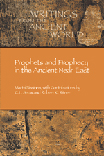
Prophets and Prophecy in the Ancient Near East
- Author: Martti Nissinen, with C. L. Seow and Robert K. Ritner
- Publisher: Society of Biblical Literature
- Publication Date: 2003
- Pages: 296
Prophecy was a widespread phenomenon, not only in ancient Israel but in the ancient Near East as a whole. This is the first book to gather the available ancient Near Eastern, extrabiblical sources containing prophetic words or references to prophetic activities. Among the 140 texts included in this volume are oracles of prophets, personal letters, formal inscriptions, and administrative documents from ancient Mesopotamia and Levant from the second and first millennia BCE. Most of the texts come from Mari (eighteenth century BCE) and Assyria (seventh century BCE). In addition, new translations of the relevant section of the Egyptian Report of Wenamon are provided by Robert K. Ritner, and C. L. Seow offers various texts from Syria-Palestine containing allusions to prophets and prophetic activities.
By collecting and presenting evidence of the activities of prophets and the phenomenon of prophecy from all over the ancient Near East, the volume illumines the cultural background of biblical prophecy and its parallels. Scholars of the history, religions, and cultural traditions of the ancient Near East are given important information about different types and forms of transmission of divine words. These valuable primary source materials are made accessible in contemporary English, along with transcriptions of the original languages, indexes, and an extensive bibliography.
Martti Nissinen is Senior Researcher at the Academy of Finland and is Professor of Old Testament Studies at the University of Helsinki.
C. L. Seow is Henry Snyder Gehman Professor of Old Testament Language and Literature at Princeton Theological Seminary. He is the author of A Grammar for Biblical Hebrew and a commentary on Daniel.
Robert Ritner is Associate Professor of Egyptology at the Oriental Institute, University of Chicago, where he received his Ph.D. in 1987. His field of study and interest is Egyptian religion, magic, medicine and social history, and Libyan cultural interactions. He is the author of The Mechanics of Ancient Egyptian Magical Practice and over 100 publications.
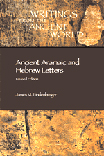
Ancient Aramaic and Hebrew Letters, 2nd ed.
- Author: James M. Lindenberger
- Publisher: Society of Biblical Literature
- Publication Date: 2003
- Pages: 212
Lindenberger presents an up-to-date translation of seventy-nine letters and fragments, virtually the complete corpus of surviving letters in Aramaic and Hebrew down to the time of Alexander, omitting only the most fragmentary and the most formulaic. This includes the correspondence from ancient Jewish writers at Yavneh-Yam (seventh century), Arad and Lachish (sixth century), and Elephantine (fifth century). There are also administrative letters from Persian bureaucrats, private commercial and family correspondence from Egypt, and other scattered letters from Assyria, Egypt, Philistia, and Idumaea. Also included are short notes in Edomite, Ammonite, and Phoenician (one in each language). The second edition is supplemented by an additional nine texts, some of them published very recently, not found in the 1994 edition. Translations are now provided with line numbers, and some have been improved in the light of recent studies. Each letter appears alongside the original text in square script. Brief introductions set each group of letters into its historical and social context. The arrangement within each language group is roughly chronological.
Lindenberger is in complete command of his material, familiar with the problems of interpreting difficult texts, and possessed of panoramic vision and discrimination of detail.
—Journal of the American Oriental Society
This fine volume belongs in every library devoted to biblical studies and the ancient world.
—Religious Studies Review
James Lindenberger is Professor of Hebrew Bible in the Vancouver School of Theology Department at the University of British Columbia, in Canada. He is the author of The Aramaic Proverbs of Ahiqar.

Texts from the Pyramid Age
- Author: Nigel C. Strudwick
- Publisher: Society of Biblical Literature
- Publication Date: 2005
- Pages: 522
Ancient Egypt is well known for its towering monuments and magnificent statuary, but other aspects of its civilization are less well known, especially its written texts. Now Texts from the Pyramid Age provides ready access to new translations of a representative selection of texts ranging from the historically significant to the repetitive formulae of the tomb inscriptions from Old Kingdom Egypt (ca. 2700-2170 B.C.). These royal and private inscriptions, coming from both the secular and religious milieus and from all kinds of physical contexts, not only shed light on the administration, foreign expeditions, and funerary beliefs of the period but also bring to life the Egyptians themselves, revealing how they saw the world and how they wanted the world to see them. Strudwick's helpful introduction to the history and literature of this seminal period provides important background for reading and understanding these historical texts.
This solid volume contains a splendidly extensive corpus of translations of Egyptian inscriptions (on stone and clay) and documents (on papyrus and sherds) from the Old Kingdom (‘Pyramid Age’) of the third millennium BCE. To the translations are prefaced introductions to the range of items presented, to third millennium Egyptian history and dating, Egyptian grammatical profile of the period, and on formal titles of officialdom, use of offering-formulae, etc., plus a survey of the range of texts drawn upon (excluding the magical/ritual ‘Pyramid Texts’, and wisdom literature). … A valuable source-book making Egypt’s Old Kingdom period much more accessible to a wider readership than hitherto.
—Kenneth A. Kitchen, Journal for the Study of the Old Testament
Nigel Strudwick is Assistant Keeper, Department of Ancient Egypt and Sudan, at The British Museum. He began his work in Egypt in 1979, and has been involved in the "Tombs of the Nobles" at Luxor since 1984. He is the co-author, with Helen Strudwick, of Thebes in Egypt: A Guide to the Tombs and Temples of Ancient Luxor, and co-editor, with Helen Strudwick, of The Encyclopedia of Ancient Egyptian Architecture.

Ancient Egyptian Pyramid Texts
- Author: James P. Allen
- Publisher: Society of Biblical Literature
- Publication Date: 2005
- Pages: 474
The Pyramid Texts are the oldest body of extant literature from ancient Egypt. First carved on the walls of the burial chambers in the pyramids of kings and queens of the Old Kingdom, they provide the earliest comprehensive view of the way in which the ancient Egyptians understood the structure of the universe, the role of the gods, and the fate of human beings after death. Their importance lies in their antiquity and in their endurance throughout the entire intellectual history of ancient Egypt. This volume contains the complete translation of the Pyramid Texts, including new texts recently discovered and published. It incorporates full restorations and readings indicated by post-Old Kingdom copies of the texts and are the first translation that presents the texts in the order in which they were meant to be read in each of the original sources.
In this book Allen offers not only an excellent new translation of the Pyramid Texts, but a wholly fresh presentation of this third millennium corpus of funerary rituals and ‘spells’. … Much in these texts is very archaic, redolent of recondite mythologies; but they are a formidable mental product in both extent and complexity, given their early date. The extensive and complex offering-ritual elements in particular stand in dramatic contrast with the tiny, brief, primitive rites (of Leviticus, for example) in the biblical corpus of over a millennium later. Allen’s work will be an invaluable reference-resource for its subject.
—Kenneth A. Kitchen, Journal for the Study of the Old Testament
James Allen is an Egyptologist, specializing in language and religion. In 2007, he became the Wilbour Professor of Egyptology at Brown University, where he teaches Egyptology and Ancient Western Asian Studies. He received his Ph.D. from the University of Chicago. Before joining Brown, he worked as the curator of Egyptian Art at The Metropolitan Museum of Art. He is the author of The Art of Medicine in Ancient Egypt.
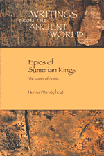
Epics of Sumerian Kings: The Matter of Aratta
- Author: Herman Vanstiphout
- Publisher: Society of Biblical Literature
- Publication Date: 2003
- Pages: 208
Epics of Sumerian Kings presents for the first time both the authoritative Sumerian text and an elegant English translation of four key epics from the Sumerian literary canon. These epics, the earliest known in any language, revolve around the conflict between the cities of Uruk (biblical Erech) in ancient Iraq and Aratta in neighboring Iran and involve two early Sumerian rulers and predecessors of Gilgamesh: Enmerkar and Lugalbanda. Of special interest is “Enmerkar and the Lord of Aratta,” which contains the story of the confounding of human language, often cited as a source of the biblical tower of Babel narrative, as well as the Sumerians’ own account of the invention of cuneiform writing.
In addition to providing English translations of the epics, Vanstiphout discusses their intellectual and cultural context, their poetics and meaning, and the significance of the epic cycle as a whole. The volume will interest scholars and students of Assyriology and the ancient Near East, biblical scholars, and general readers and will be a valuable text for courses on ancient Near Eastern literature or history.
Herman Vanstiphout is Associate Professor in the Department of Languages and Cultures of the Middle East at the University of Groningen in the Netherlands. He is the author of Genre in Mesopotamian Literature and co-authored Aspects of Genre and Type in Pre-Modern Literary Cultures.
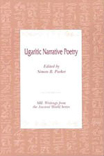
Ugaritic Narrative Poetry
- Translators: Mark S. Smith, Simon B. Parker, Edward L. Greenstein, Theodore J. Lewis, and David Marcus
- Publisher: Society of Biblical Literature
- Publication Date: 1997
- Pages: 265
More than five hundred years before the Odyssey and the Iliad, before the biblical books of Genesis or Job, masters of the epic lived and wrote on the Mediterranean coast. The Ugaritic tablets left behind by these master scribes and poets were excavated in the second quarter of the twentieth century from the region of modern Syria and Lebanon and are brought to life here in contemporary English translations by five of the best known scholars in the field. Included are the major narrative poems Kirta, Aqhat, and Baal, in addition to ten shorter texts, newly translated with transcriptions from photographs using the latest techniques in the photography of epigraphic materials.
Mark Smith is Professor of Hebrew and Judaic Studies at New York University. He received his Ph.D. from Yale University where he studied Northwest Semitics and Hebrew Scripture. He is the author of The Early History of God as well as other books on the Hebrew Bible, the Dead Sea Scrolls, and West Semitic mythology and literature.
Simon Parker was a School of Theology and Graduate School of Arts and Sciences professor at Boston University, where he specialized in the Hebrew Bible. The late professor received his Ph.D. from Johns Hopkins University and taught at Reed College before arriving at BU in 1977. His scholarly work focused on the interpretation of biblical literature in its ancient literary, religious, and social contexts.
Edward Greenstein is Professor of Bible at Bar-Ilan University. He has taught at Tel Aviv University and The Jewish Theological Seminary. He has published in the fields of Hebrew Bible and ancient Semitic language and culture, as well as literary theory and Biblical narrative. He is the author of Essays on Biblical Method and Translation.
Theodore Lewis received his Ph.D. at Harvard University, studying Near Eastern Languages and Civilizations. He has the honor of being the first Blum-Iwry Professor in Near Eastern Studies at Johns Hopkins University.
David Marcus is a professor of Bible at The Jewish Theological Seminary. He teaches on the Bible and ancient languages, including Babylonian Aramaic. He is the author of numerous articles and his most recent book is a critical edition of Ezra-Nehemiah for the new Biblia Hebraica Quinta series. He received his Ph.D. from Columbia in the Department of Middle East Languages and Cultures.
Reviews
2 ratings
Nathan Minor
6/22/2024
This doesn't seem to have the latest editions of the collection unfortunately. For example James P. Allen provided a second edition of "The Ancient Egyptian Pyramid Texts" in 2014.
Unix
1/12/2016